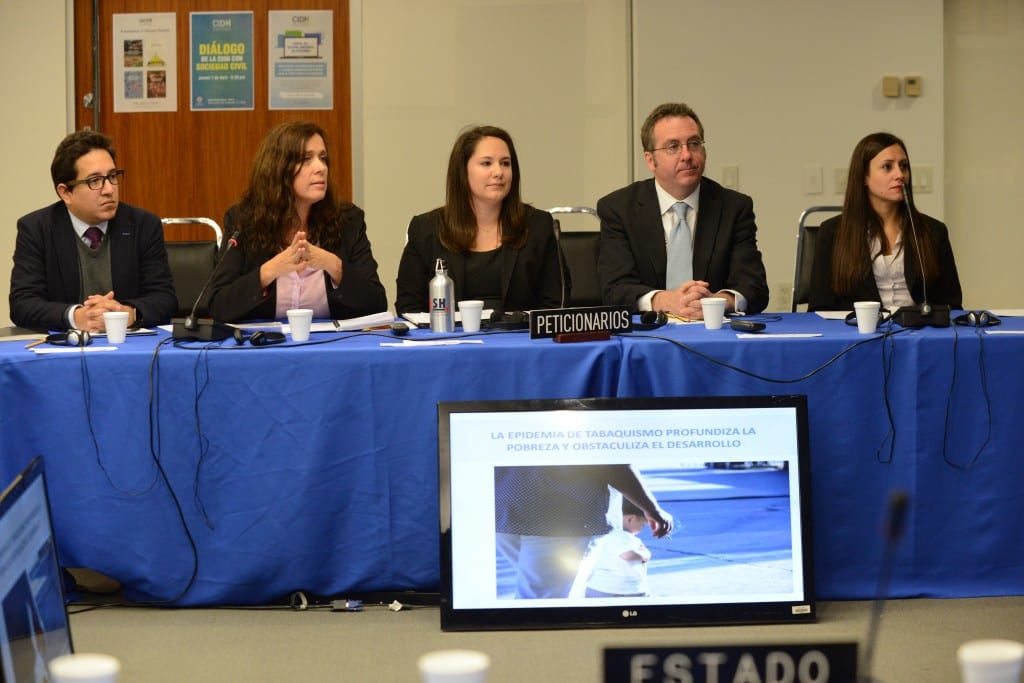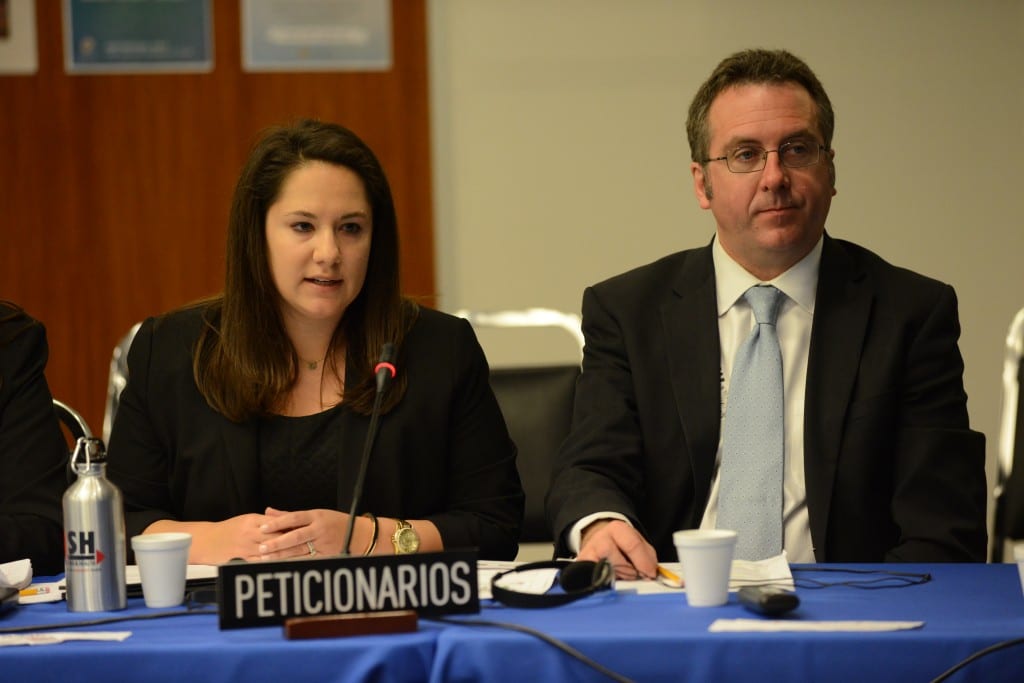View the presentation powerpoint in Spanish and in English. Talking points are below per speaker. Video Disclaimer: The first two presenters will speak in Spanish. ASH staff present third and fourth in English.
Background and press information can be found here.

Credit: Daniel Cima, IACHR
1. Oscar A. Cabrera, The O’Neill Institute for National and Global Health Law, Georgetown University, Washington DC
2. Verónica Schoj, Fundación Interamericana del Corazón Argentina
3. Kelsey Romeo-Stuppy, ASH > Action on Smoking and Health, Washington, DC
Slide- Tobacco Industry In Its Own Words
Good morning, I’m Kelsey Romeo-Stuppy, Staff Attorney for Action on Smoking and Health. For the next few minutes, I would like to share with you some examples of what the tobacco industry has to say about themselves and their products and also illustrate how the tobacco industry influences social perception about tobacco.
The tobacco industry markets and sells products that they know to be deadly. In fact, they intentionally advertise to women, young people, children and vulnerable groups such as the LGBT community.

In 1998, the Attorney’s General of 46 states came to an agreement with the 5 biggest U.S. tobacco companies about advertising and marketing of tobacco products. During that legal action, thousands of pages of internal industry documents were produced as evidence. Much of what we will share with you today is from those documents. That is how we can truly show the difference between what the tobacco industry knew, and what they said.
Slide- Lied for decades
On this slide, you will see that the internal industry documents tell us that by 19533, RJ Reynolds knew that tobacco causes lung cancer. However, RJ Reynolds and other tobacco companies continued to misrepresent that information and confuse the public about the health effects of tobacco for decades.
The picture on the previous slide, of the men testifying before the United States Congress, was taken in 1994. On that day, 7 tobacco executives swore before Congress that they did not believe that nicotine was addictive. However, internal documents show that the industry knew all about the addictiveness of nicotine- from as early as 1963.
Slide- They got lips?
From the internal documents and even some public statements, we have also found out some of the ways that the tobacco industry targets customers.
Many forms of advertising to children in the U.S. were banned by the 1998 master settlement agreement I previously mentioned, including using cartoons, billboards and free samples.
However, the industry still needs replacement smokers to continue to buy their products as their current customers die from tobacco related diseases. As my colleague will demonstrate later in the presentation, the industry still finds many ways to target children around the world. They have illustrated cigarettes as healthful, slimming, glamourous, adventurous and cool. The industry has grown and changed with the times, and they market to what the current societal standard of “cool” is.
Slide- Project SCUM
The tobacco industry has made a point of targeting vulnerable populations other than children as well. This slide shows a business plan, found in the internal documents, that targets, among others, the LGBT community and the homeless population of San Francisco. RJ Reynolds nicknamed the plan “Project SCUM.”
In addition to advertising, tobacco corporations have utilized many approaches to mislead the public about the harms of tobacco.
One common tool has been “junk science.” The tobacco industry has funded scientific studies that are designed to make their products look less dangerous. This helped them build credibility, develop industry-friendly experts, and create confusion about the health effects of their products.
The industry has also paid doctors to testify on their behalf. For example, 6 physicians have been paid to repeatedly testify that cigarettes do not cause head and neck cancers, despite overwhelming scientific consensus that they do.
Thank you.
4. Chris Bostic, ASH > Action on Smoking and Health, Washington, DC
Slide 1

As we’ve heard, tobacco use is the leading cause of preventable death in the Americas and the world. But we know how to prevent it – the WHO Framework Convention on Tobacco Control. The only requirement to implementing the FCTC is political will.
The tobacco industry is keenly aware of this, and has made sapping political will part of its basic business model. While there is often friction between the interests of commerce and the interests of public health, for tobacco it is different. The FCTC itself recognizes that there is a fundamental and irreconcilable conflict of interest between the tobacco industry and governments’ public health goals.
The tobacco industry impedes public health policy in a number of ways, many of which we will not be able to address today.
Let me just mention one key industry strategy – litigation.
The tobacco industry has launched hundreds of cases in response to public health measures at the local, national and international levels. The map above is simply a snapshot of major litigation over a recent two-year period.
There is no other business which makes litigation such a major part of its day-to-day functioning. Rule of law is a vital component of modern democracy, and everyone has the right to seek justice. But the tobacco industry abuses this right to a startling degree.
The tobacco industry knows that it does not need to win cases in order to create what is often termed regulatory chill. The mere threat of costly litigation is often enough. Far too often, governments decide not to risk financial catastrophe and back away from strong tobacco control measures.
Slide 2
Litigation under trade agreements is a well-publicized example of the tobacco industry’s global litigation strategy. Typically in other commercial sectors, such cases cost governments between $3 and 8 million in legal costs, not including any settlement.
However, it is part of the tobacco industry’s strategy to inflict the greatest legal costs possible on governments. Cases are intentionally dragged out and made more complicated in order to increase legal costs.
Slide 3
In December 2015, Australia won its trade case against Philip Morris International over its standardized packaging law.
That case cost the Australian government over $50 million, in spite of the fact that the case was thrown out on jurisdictional grounds without ever getting to the merits of the case.
The Uruguayan government is facing a similar suit from Philip Morris, which has already dragged on for years. It will likely cost the tobacco industry far more than their profits from such a small market. But market share in Uruguay is not the industry’s main concern – they know that other governments are unlikely to follow Uruguay’s example if litigation costs in this case are huge. We know that tobacco regulations were dropped in response to trade litigation threats in Togo, Namibia, the Solomon Islands and even Canada.
Slide 4
The tobacco industry is also adept at buying the favor of politicians, through contributions to political campaigns, through lobbying and through outright bribery.
This headline is just one of the most recent, well-documented accusations.
An example from the Americas is illustrative of how the tobacco industry directly influences government officials.
Throughout the 1990s, British American Tobacco and Philip Morris co-ran the so-called “Latin Project”, which paid doctors and scientists to publish selective data to counter the science on secondhand smoke, in order to prevent smoke-free air regulations. This was long after the tobacco industry knew the dangers of secondhand smoke.
In a moment, you will hear more examples of industry interference in the Americas, but I wanted to put these efforts in a global context.
Such actions by the tobacco industry bring up rights well beyond health and life. Issues of political rights, corruption, and justice, to name a few, should also be considered.
And while these are the acts of private corporations, it is government regulations, lack of enforcement and international laws that give space for the tobacco industry to maneuver. The dynamic between the tobacco industry and governments can be changed, and in fact must be changed under the FCTC.
5. Belén Rios, Fundación Interamericana del Corazón Argentina



